
Until the end of the last ice age, American cheetahs, enormous armadillo-like creatures and giant sloths called North America home. But it's long puzzled scientists why these animals and other megafauna — creatures heavier than 100 pounds (45 kilograms) — went extinct about 10,000 years ago.
Rapid warming periods called interstadials and, to a lesser degree, ice-age people who hunted animals are responsible for the disappearance of the continent's megafauna, according to a study published in 2015 in the journal Science. Other studies have placed more blame on humans, and some researchers say many factors are to blame.
Both research and the debate surrounding the reasons for the extinction of these animals will undeniably continue. In the meantime, researchers continue to find fossils of these massive creatures. Here's a look at 15 extinct animals from the last North American ice age, and what scientists know about their lives.
Related: 25 of the strangest ancient sea monsters
1. Saber-toothed cat
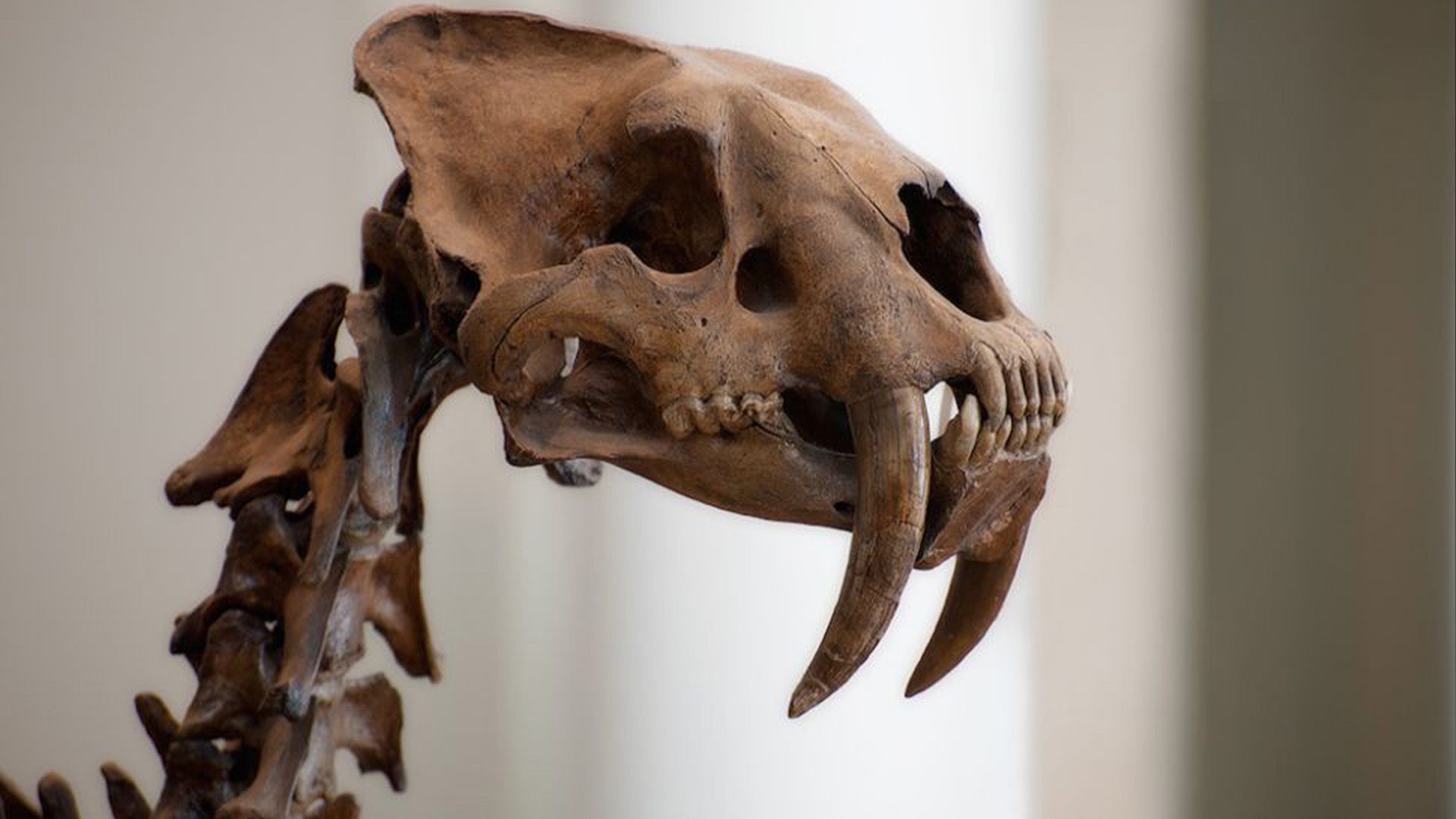
The saber-toothed cat (Smilodon fatalis) lived from about 400,000 to 11,000 years ago, according to the Natural History Museums of Los Angeles County. It was a big feline, weighing around 350 to 620 pounds (160 to 280 kg) and measuring an average of about 5.75 feet (1.75 meters) from its rump to its snout, not including its tail, according to the San Diego Zoo Wildlife Alliance. S. fatalis was about the size of a modern African lion (Panthera leo) but with shorter and more robust limbs. Its blade-like, serrated canine teeth, or sabers, were impressively big, at nearly 7 inches (18 centimeters) long.
2. Ice age coyote
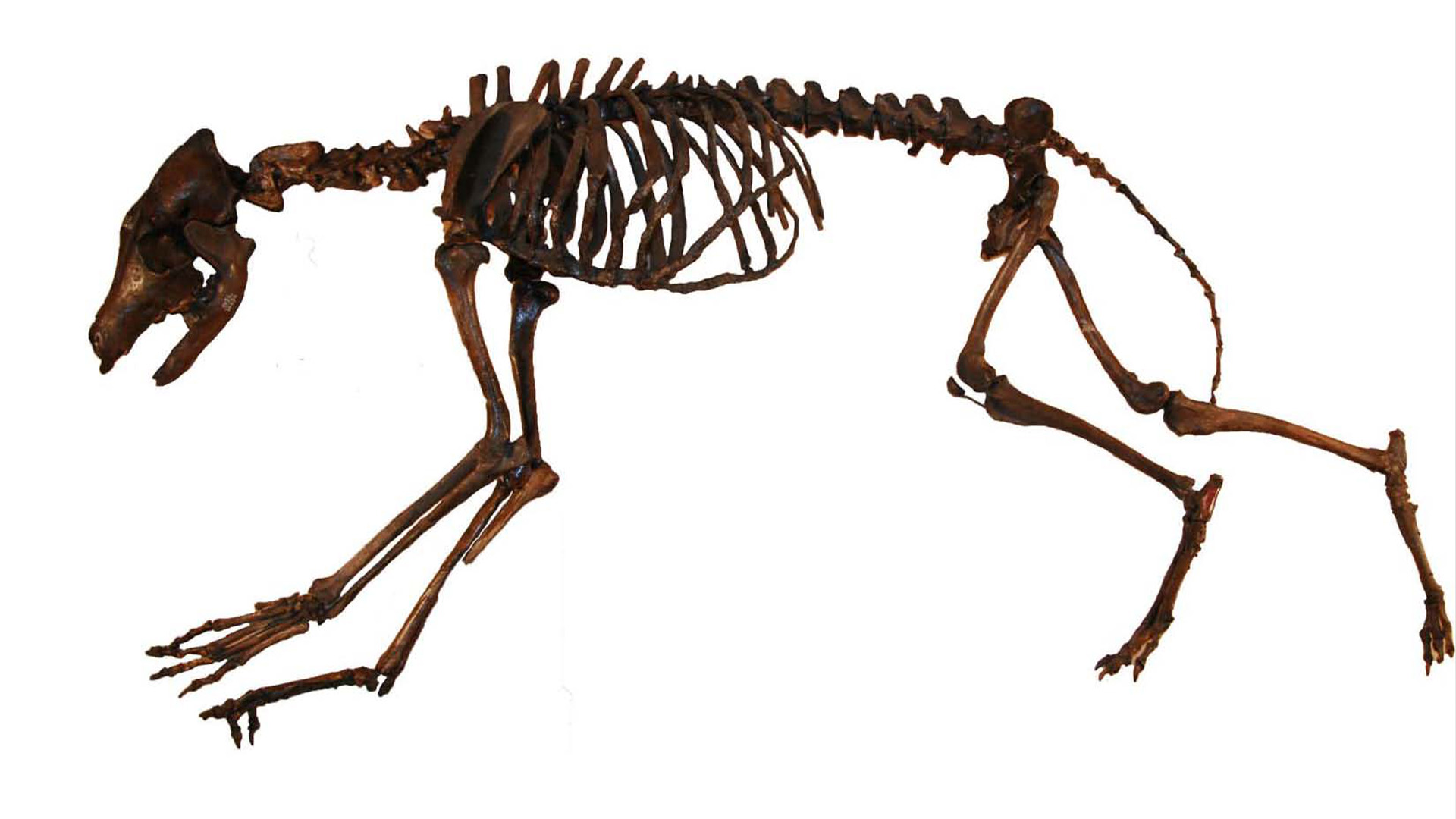
The ice age coyote (Canis latrans orcutti), also known as the Pleistocene coyote, was much larger than today's coyotes. The ancient member of the family Canidae weighed between 33 and 55 pounds (15 to 25 kg), meaning that some were as large as some modern-day wolves (Canis lupus), a 2012 study in the journal PNAS found. Today's coyotes (Canis latrans) weigh only around 22 to 40 pounds (10 to 18 kg), according to a statement describing the study.
Compared with today's coyotes, the Pleistocene coyote had a thicker, deeper skull and better teeth for eating meat. These features suggest the Pleistocene canine could kill larger prey and was more carnivorous, the study found.
3. Ancient bison
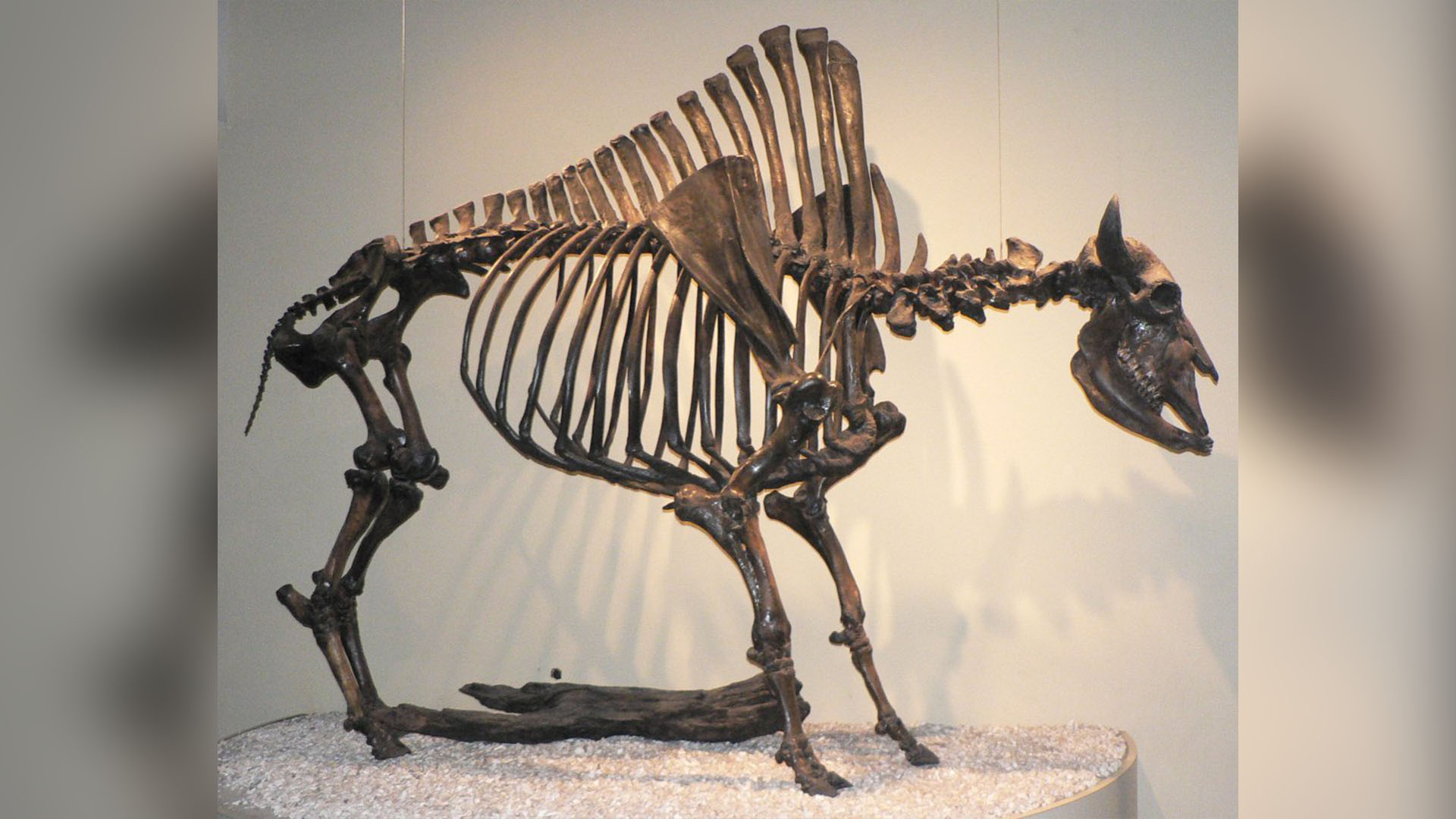
The ancient bison (Bison antiquus) lived from about 240,000 to 10,000 years ago, according to the National Park Service (NPS). It was 25% larger than the modern American bison (Bison bison), at 7.5 feet (2.3 m) high, 15 feet (4.6 m) long and 3,500 pounds (1,600 kg). Its horns were also longer than those of modern bison. These herbivores are likely ancestral to American bison, according to the NPS.
4. Ancient walrus
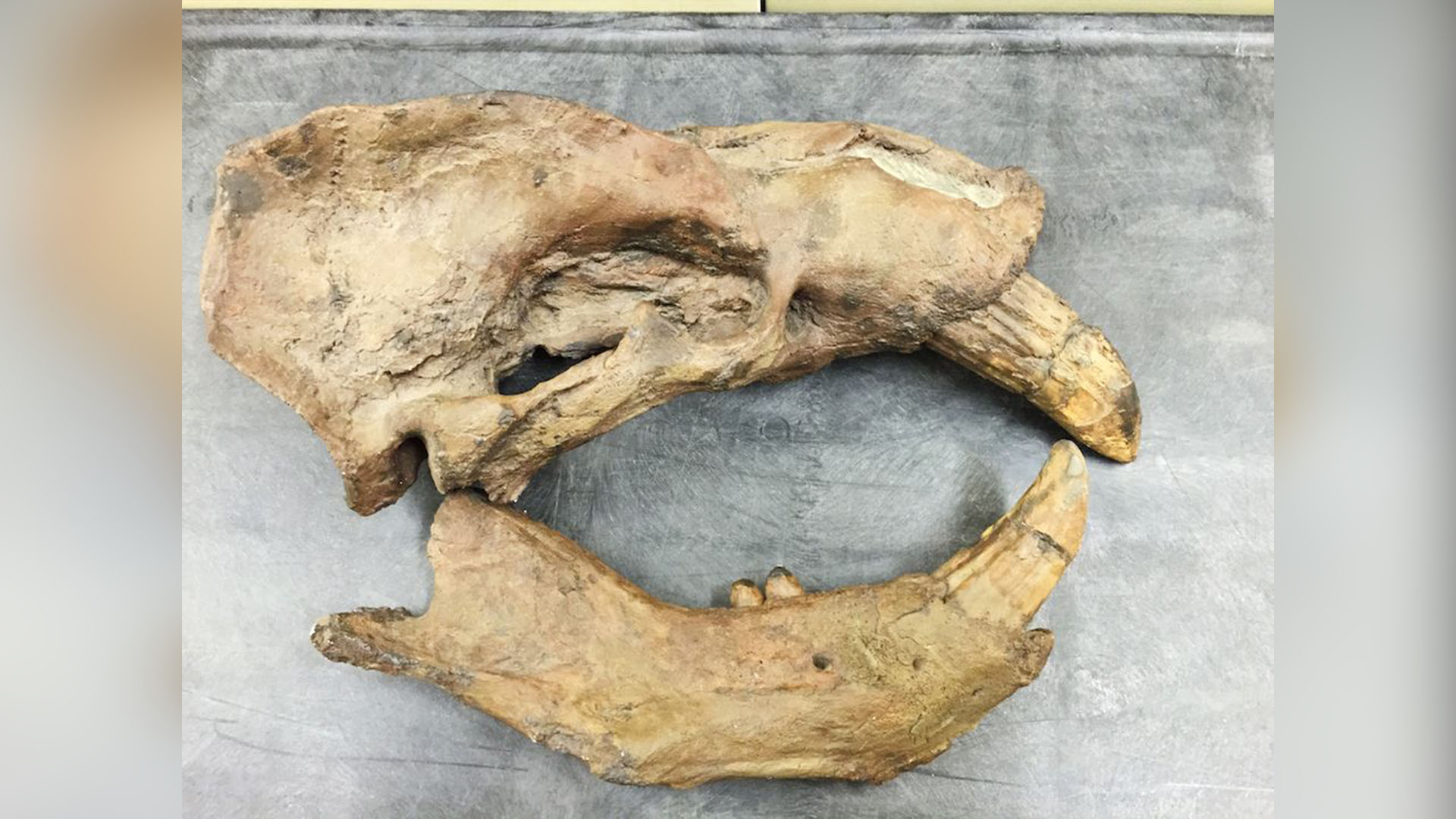
In 1980, researchers found the near-complete remains of Gomphotaria pugnax — a now-extinct giant pinniped — in Southern California. G. pugnax lived about 8.5 million to 5 million years ago, during the late Miocene epoch, the scientists reported in the journal Contributions In Science. Its large 18.5-inch-long (47 cm) skull had large upper and lower canine tusks. The ancient walrus likely swam in shallow waters and used these tusks to stir up sediment on the seafloor while searching for food, most likely hard-shelled invertebrates such as mollusks.
"In life, G. pugnax was apparently a huge, heavybodied pinniped, with a high forehead (at least in the males, like the California sea lion, [Zalophus] californianus) and small eyes," the researchers wrote in the study.
5. Scimitar-toothed cat
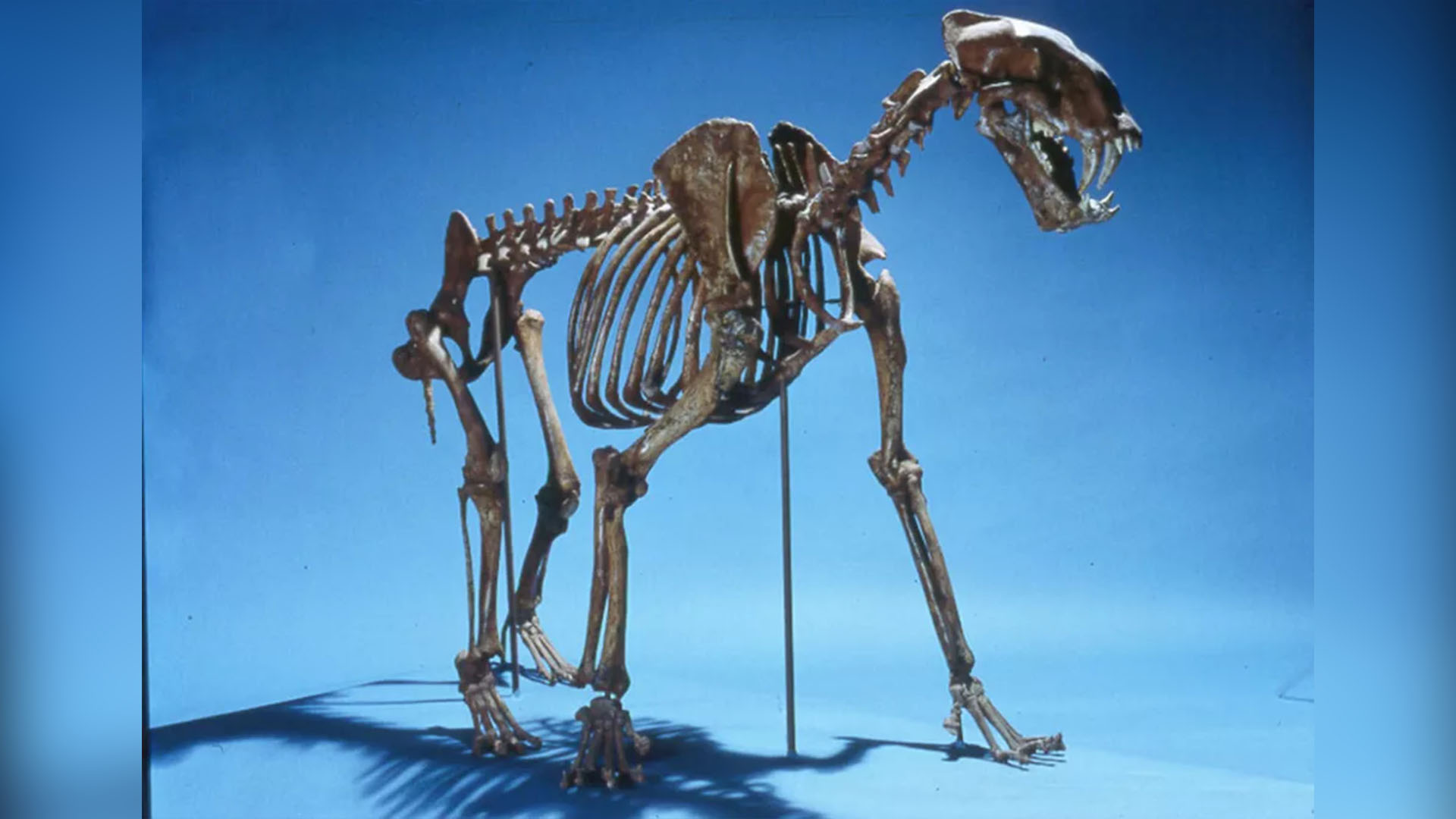
The scimitar-toothed cat (Homotherium) had large canine teeth, powerful forelimbs, a sloping back and a large optic bulb, all of which made it a deadly predator during the Pleistocene, according to a 2020 study in the journal Current Biology. Fossils of the ancient cat have also been found in Eurasia, but during the last ice age, the animal crossed the Bering Land Bridge and started living in North America. Its fossilized remains have been found at the La Brea Tar Pits in Southern California and other parts of the U.S., including Alaska, Idaho and Texas.
6. North American horses
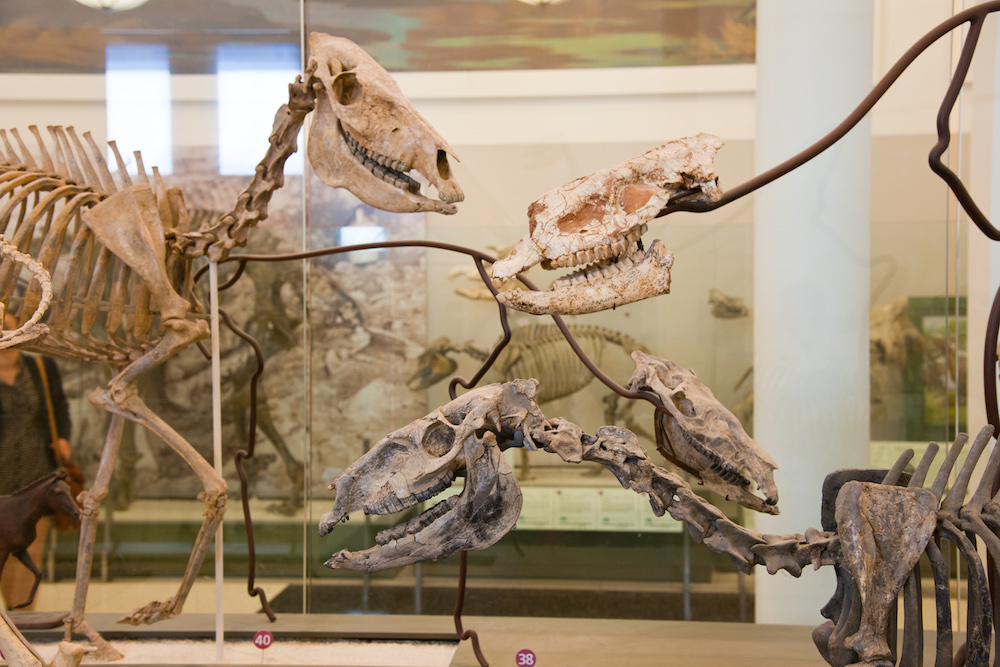
European settlers introduced horses when they landed in the New World. But little did they know the thunderous sound of ancient horses' hooves once covered the continent.
Ancient horses lived in North America from about 50 million to 11,000 years ago, when they went extinct at the end of the last ice age, said Ross MacPhee, curator emeritus of mammalogy at the American Museum of Natural History in New York City.
"One of the great peculiarities of this extinction is that they died out in North America, yet managed to survive in Eurasia and Africa, which is why we still have horses and their relatives — donkeys and asses — today," MacPhee told Live Science.
7. Glyptodon
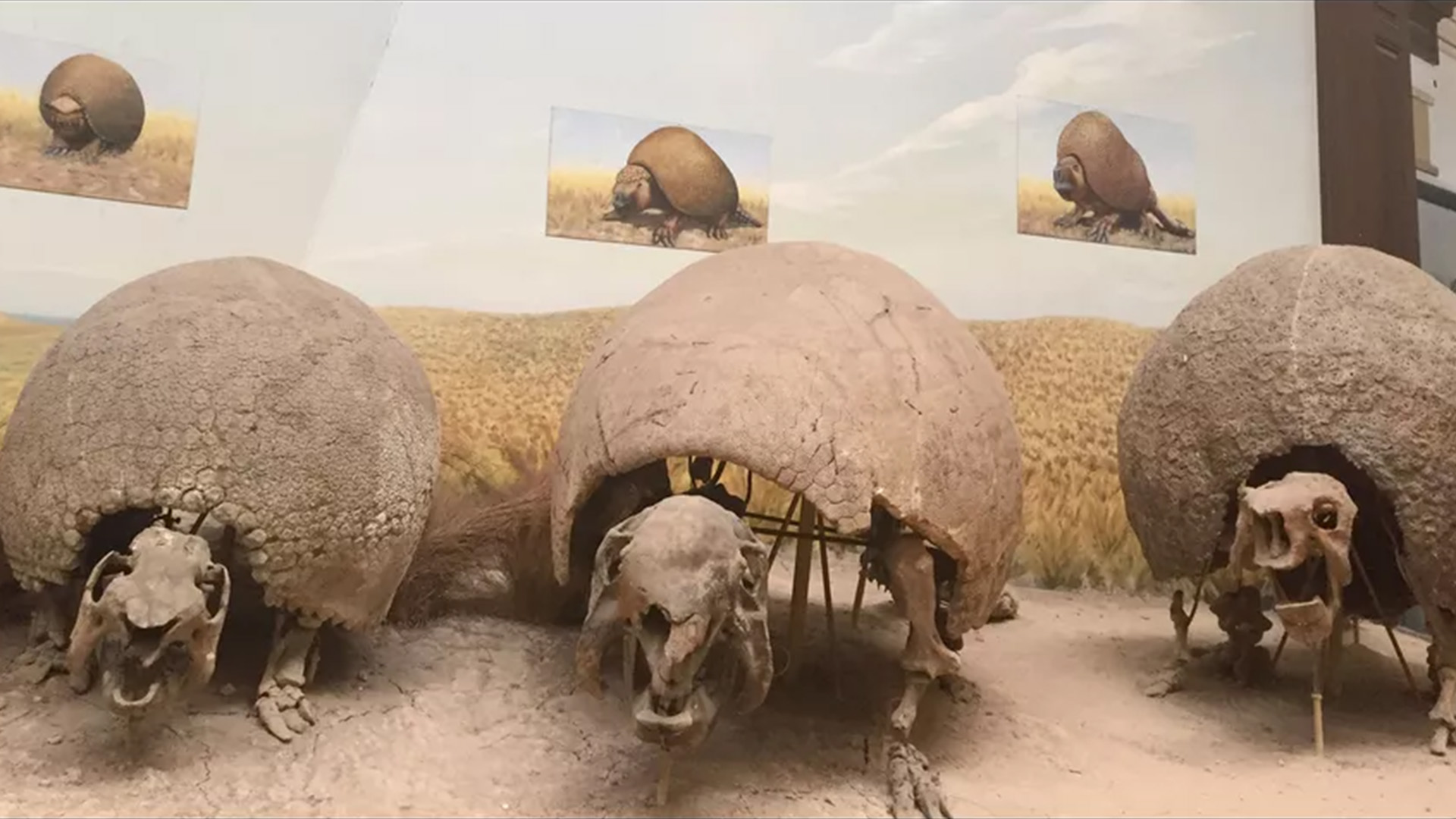
Glyptodon looked like a supersize version of its distant relative, the armadillo. Like its cousin, Glyptodon protected itself with a shell made of bony plates.
The armored, 1-ton creature likely traveled to North America from South America via the Isthmus of Panama, a land bridge that connects the two Americas, MacPhee told Live Science.
After reaching North America about 2 million years ago, Glyptodon prospered in what is now coastal Texas and Florida, he said. But the herbivorous critter has been extinct for 10,000 years, MacPhee said.
8. Mastodons
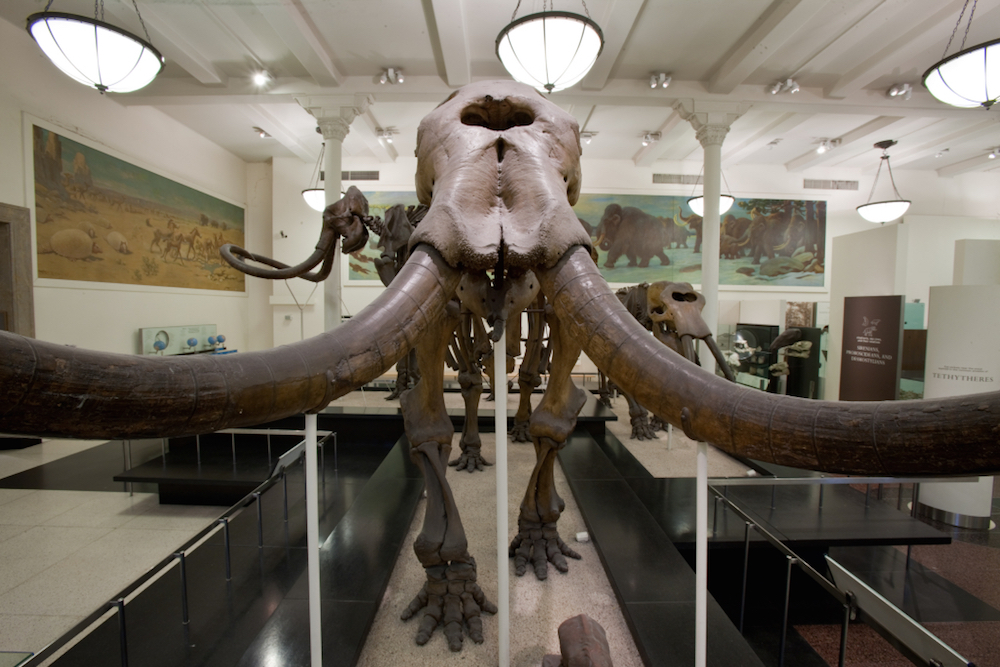
Mastodons (Mammut) entered North America about 15 million years ago, traveling over the Bering Strait land bridge, long before their relative, the mammoth, according to the Yukon Beringia Interpretive Centre in Canada.
They were also more primitive than their mammoth cousins. For instance, mastodons had less-complex teeth — cone-shaped cusps on their molars — that helped them crunch on the leaves, twigs and branches of deciduous and conifer trees. They also ate wetland plants that weren't full of abrasive material found in terrestrial plants, MacPhee said.
Related: Mammoth or mastodon: What's the difference?
Mastodons are also a bit shorter than mammoths, but both species reached heights between 7 and 14 feet (2 to 4 m). And both had shaggy coats that protected them from the cold.
However, mastodons had long, curved tusks that measured up to 16 feet (4.9 m) long. Mammoths, in contrast, sported curlier tusks.
9. Mammoths

Mammoths (Mammuthus) traveled to North America about 1.7 million to 1.2 million years ago, according to the San Diego Zoo. Although there are some anatomical differences between mammoths and mastodons, both are members of the proboscidean family. Mammoths had fatty humps on their backs that likely provided them with nutrients and warmth during icy periods.
Mammoths also had flat, ridged molars — a structure that helped them slice through fibrous vegetation, unlike the cusped teeth of the mastodon, MacPhee said.
In addition, mammoths are more closely related to modern elephants, especially the Asian elephant, than mastodon, MacPhee said.
Related: Dwarf elephants and shedding mammoths shine at NYC's 'Secret World of Elephants'
10. Short-faced bear

Despite its name, this enormous bear didn't actually have a short face. But in comparison to its long arms and legs, it looked like it did, MacPhee said. He compared it to a grizzly bear on stilts, as its limbs were at least one-third longer than those of a modern grizzly.
"It had very long forelimbs and hind limbs," which likely helped it run at high speeds, he said. Modern bears are capable of short bursts of speed, "but they're not runners," he said.
However, the bear's long limbs still perplex scientists.
"One idea is that short-faced bears ran down their prey like cats do, but for a whole number of reasons, that is no longer the preferred argument," he said. "We don't know why they were adapted to having long legs."
Now, researchers are looking for clues that may reveal whether the carnivore was a hunter, a scavenger or both, MacPhee said.
11. Dire wolf
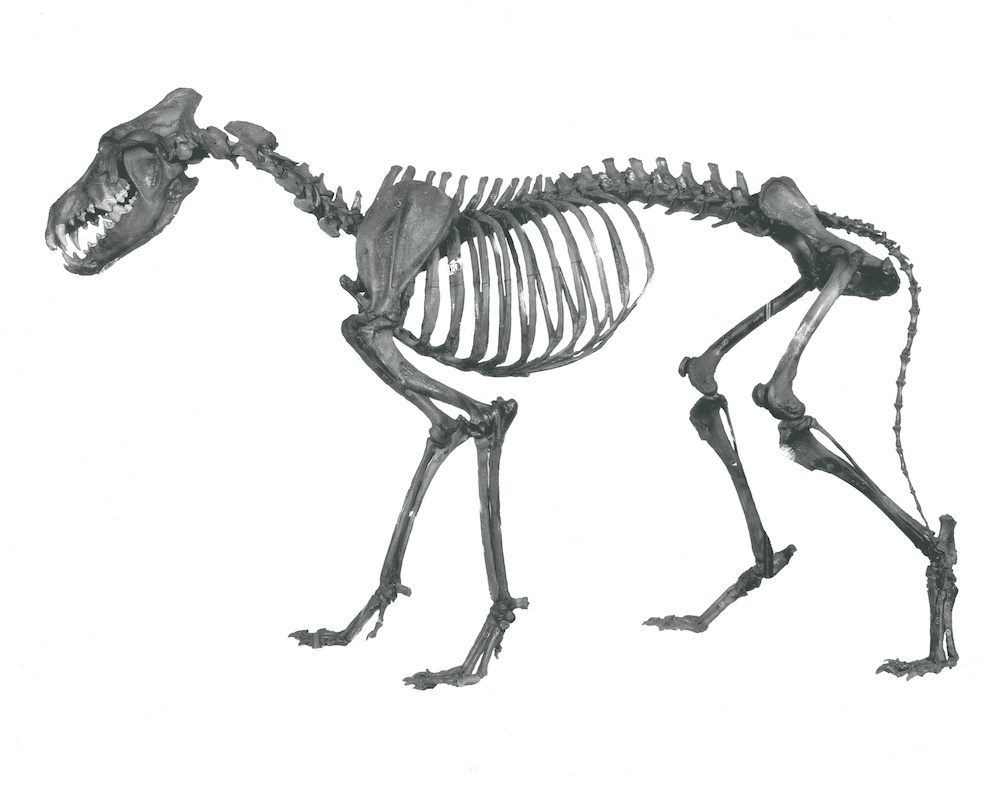
Dire wolves went extinct about 13,000 years ago, but their bones are plentiful in California's La Brea Tar Pits and Wyoming's Natural Trap Cave. These skeletons show that dire wolves (Canis dirus) were about 25% heavier than modern gray wolves (Canis lupus), weighing between 130 and 150 pounds (59 to 68 kg), according to the Florida Museum of Natural History.
However, the dire wolf had shorter limbs than C. lupus, suggesting it wouldn't have won any races against its younger relative, the museum reported.
On the canid family tree, dire wolves split off from wolves about 5.7 million years ago, making them a distant relative of today's wolves, according to 2021 study published in the journal Nature. Unlike other canid species that migrated between Eurasia and North America, dire wolves evolved solely in North America, and they didn't interbreed with coyotes or gray wolves, the study found.
12. American cheetah
The American cheetah stood a little taller than the modern cheetah, with a shoulder height of about 2.75 feet (0.85 m) and a weight of about 156 pounds (70 kg). However, the American cheetah probably wasn't as fast: It had slightly shorter legs, which likely made it a better climber than a runner, according to the San Diego Zoo.
Researchers named it Miracinonyx inexpectatus — mira means "wonderful" in Latin, and acinonyx and onyx come from the Greek words for "no movement," (based on the false perception that cheetahs don't have retractable claws) and claw, respectively, the zoo said. Inexpectatus is Latin for "unexpected," giving the big cat a name that translates roughly into "wonderful unexpected cheetah with immobile claws."
Researchers dated the first known M. inexpectatus fossil, found in modern-day Texas, to the Pliocene, between 3.2 million and 2.5 million years ago, according to the zoo. They went extinct about 12,000 years ago.
13. Ground sloth
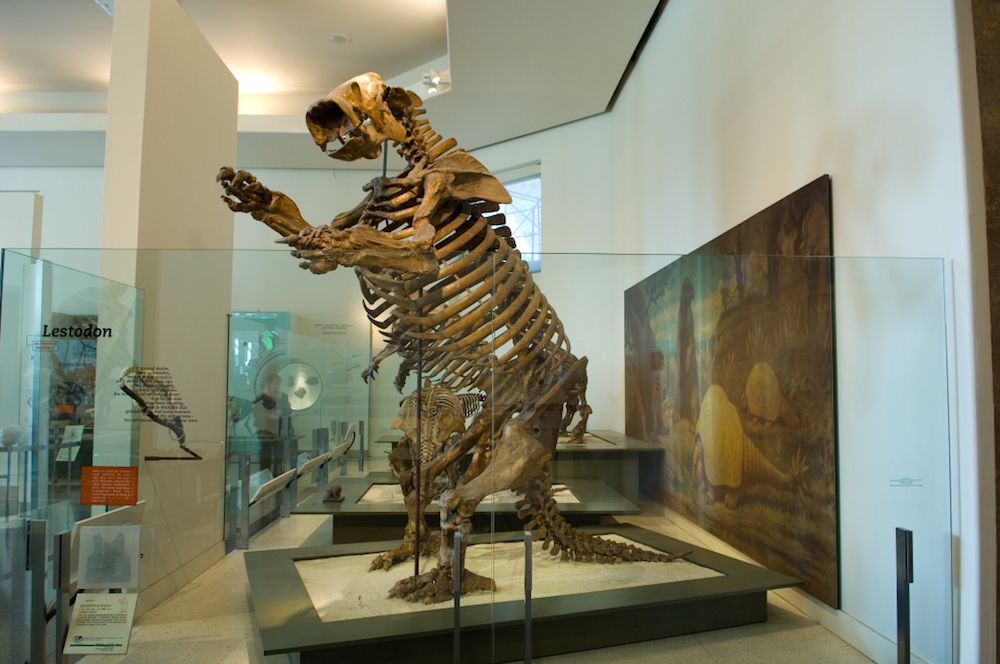
When President Thomas Jefferson learned about a strange claw fossil found in Ohio, he asked explorers Meriwether Lewis and William Clark to search for giant lions during their western trek to the Pacific. The claw, however, didn't belong to a lion. It was part of Megalonyx, an extinct ground sloth, MacPhee said.
Like Glyptodon, Megalonyx traveled to North America from South America. In fact, ground-sloth fossils indicate that these animals began living in South America about 35 million years ago, according to the San Diego Zoo.
Researchers uncovered a 4.8 million-year-old Megalonyx fossil in Mexico, and later, specimens were found in present-day America, especially in areas that used to have forests, lakes and rivers. During warmer periods, called interglacials, Megalonyx made it as far north as the Yukon and Alaska, MacPhee said.
"But when it got cold, the sloth really wasn't built for that type of thing, so it headed south," he said.
Megalonyx jeffersonii stood about 9.8 feet (3 m) tall and weighed an estimated 2,205 pounds (1,000 kg). It survived until about 11,000 years ago, the zoo reported.
14. Giant beaver
The giant beaver (Castoroides) is mostly known from its fossils in the Great Lakes region, which is "perhaps no surprise for a beaver," MacPhee said. But other fossil finds show the giant lived as far south as South Carolina and in the American Northeast.
Like Megalonyx, the giant beaver ventured into Alaska and the Yukon during the interglacial periods, but retreated south when temperatures dropped, MacPhee said.
Castoroides was enormous for a beaver — it weighed up to 125 pounds (57 kg), much larger than the roughly 44-pound (20-kg) North American beaver (Castor canadensis) that exists today. Interestingly, modern beaver remains are found in the same deposits as those of their ancient relatives, suggesting they had similar lifestyles, MacPhee said.
15. Camels
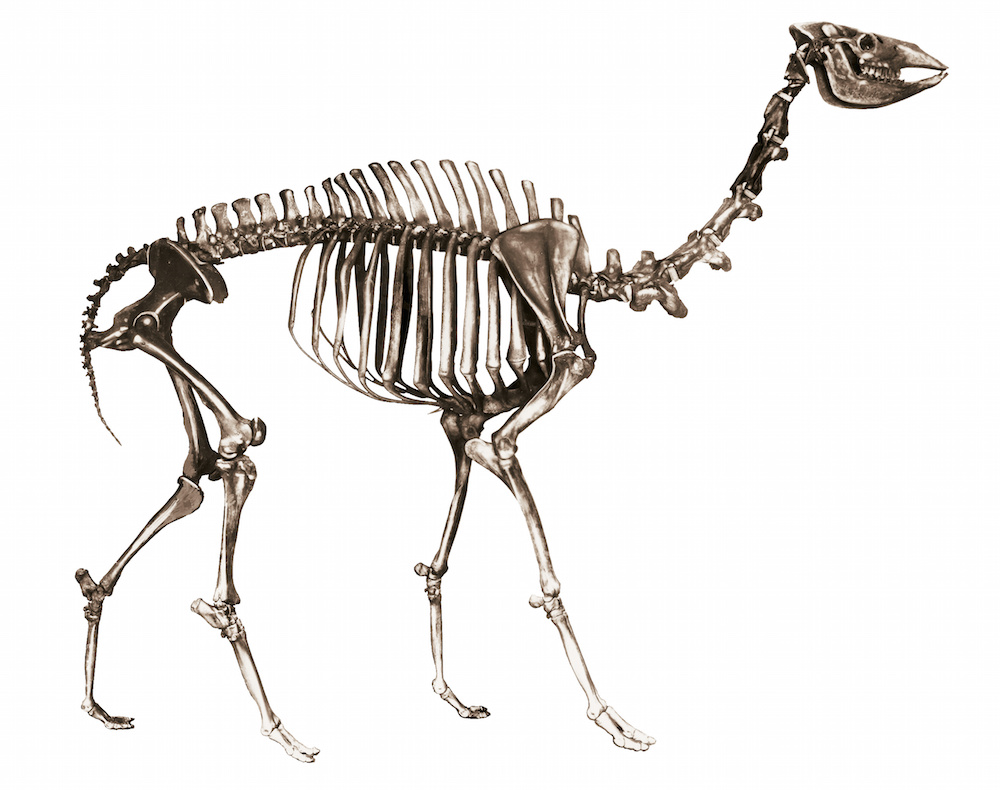
Camels that once roamed North America are called Camelops, Latin for "yesterday's camel." However, Camelops is more closely related to llamas than to today's camels, the San Diego Zoo reported.
Camelops and its ancestors were no strangers to the states. Fossils show that the camelid family arose in North America during the Eocene period, about 45 million years ago, the zoo said. It lived in open spaces and dry areas, but it's unclear whether it could conserve water as modern camels do, MacPhee said.
Camelops stood about 7 feet tall (2.2 m) at its shoulder, weighed up to 1,764 pounds (800 kg) and had a short tail.
Editor's note: This was originally published on Aug. 15, 2015, and was updated on April 29, 2024, to add five animals.







